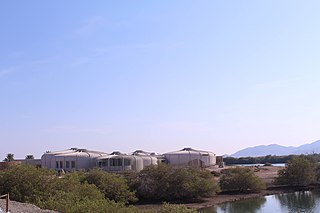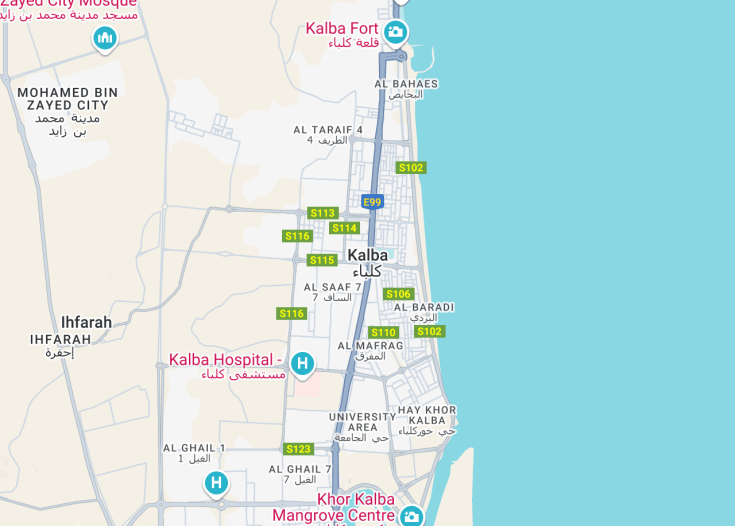Kalba, a quaint coastal town in the Sharjah emirate of the United Arab Emirates, is nestled along the Gulf of Oman. Renowned for its rich history and natural reserves, this serene destination offers a blend of cultural heritage and ecological wonders. Explore ancient forts, vibrant souks, and the captivating Kalba Bird of Prey Centre. Its tranquil mangrove surrounds make it a perfect spot for nature lovers and bird watchers.
Plan your visit during the cooler months from November to March for a more comfortable exploration of Kalba’s outdoor attractions.
Consider hiring a local guide to fully experience Kalba’s historical sites and natural habitats, enriching your understanding of the area’s unique ecology and culture.
Top things to do & see in Kalba
Select the following sights and activities to discover best tickets and tours available in Kalba.
Kalba: An Emirati Coastal Gem
| Country | United Arab Emirates |
| Time in Kalba | GMT+4 |
| Language spoken | Arabic |
| Population | 37,545 (According to the latest data) |
| Currency | UAE Dirham (AED د.إ) |
| Airports |
|
Kalba, located in the United Arab Emirates, is a historic city known for its serene landscapes and rich cultural heritage. Nestled on the eastern coast of the Sharjah Emirates, it is famed for its biodiversity, particularly the mangrove swamps which are a haven for a wide variety of wildlife. This city, although smaller when compared to major UAE cities, carries its charm through its historical sites and the relaxing Kalba Corniche, which offers spectacular views of the Arabian Gulf. Historically, Kalba was known for its music and scholars, adding a rich cultural layer to its coastal beauty.
Where is Kalba?
Kalba is situated on the eastern coast of the United Arab Emirates, adjacent to the Gulf of Oman.
Distances:
| Route | Distance by car | Time by car |
|---|---|---|
| Dubai to Kalba | 88 miles (141 km) | 1 hour 30 minutes |
| Sharjah to Kalba | 70 miles (113 km) | 1 hour 15 minutes |
| Abu Dhabi to Kalba | 153 miles (246 km) | 2 hours 15 minutes |
What is Kalba famous for?
Kalba is renowned for its natural reserves such as the Khor Kalba Conservation Reserve, which hosts some of the oldest mangrove forests in Arabia and is a vital site for endangered species like the Arabian-collared kingfisher.
History
Prehistoric Period to Early Islamic Era
The history of Kalba, a town in the United Arab Emirates, can be traced back to ancient times when it was primarily inhabited by semi-nomadic tribes who relied on fishing and date palm cultivation. Archaeological finds suggest the presence of early human settlements in the region, dating back to the Bronze Age. Kalba’s strategic location along the east coast of the Arabian Peninsula made it a focal point for trade routes linking the interior regions with the Indian Ocean. During early Islamic times, Kalba served as a minor port along the Gulf of Oman, facilitating regional trade and communication.
1500s – Late 19th Century
During the 16th century, Kalba came under the influence of Portuguese explorers and traders who sought control over the regional trade routes. The Portuguese built forts and established trading posts but faced resistance from local tribes. The town’s importance continued into the 17th and 18th centuries under various local sheikhdoms who governed the area. In the late 19th century, Kalba became part of the Trucial States, an arrangement that placed it under the protective area of the British Empire, reducing conflicts with neighboring regions.
20th Century – Present
The discovery of oil in the UAE profoundly transformed the region, including Kalba. However, unlike other emirates, Kalba did not experience the same level of economic boom from oil but focused on fishing and agriculture, preserving its rich cultural heritage and natural environment. In recent decades, it has seen gradual development with improvements in infrastructure and the growth of the tourism industry, emphasizing ecotourism and the preservation of its biodiversity. Kalba is now celebrated for its unique mangrove forests, wildlife, and historical sites, positioning it as a significant cultural and ecological destination in the modern UAE.
Visit Kalba
What to see and do in Kalba, United Arab Emirates
A visit to Kalba is a journey through both time and nature. Start at the Kalba Bird of Prey Centre for an up-close experience with incredible birds of prey, indicative of the region’s commitment to wildlife preservation. Wander through the picturesque Kalba Corniche, offering serene waterfront views and a relaxing atmosphere. For history enthusiasts, the Hisn Kalba Fort, a recently renovated 16th-century fort, now serves as a museum showcasing local history and archaeology.
- Explore the Mangrove Wetlands, an ecologically significant site home to diverse bird species.
- Visit the Shees Park, a beautifully landscaped area featuring a striking waterfall and walking paths.
- Try kayaking in the calm waters of the Kalba mangrove forest, an adventurous yet tranquil experience.
Festivals in Kalba
Kalba hosts several cultural and nature-based events throughout the year, drawing visitors to celebrate its unique heritage and natural beauty. The Kalba Fish Festival, typically held in April, highlights traditional fishing techniques and local seafood. The Khor Kalba Turtle and Wildlife Sanctuary also organizes annual events focused on conservation education and community engagement.
Best time to visit Kalba
The best time to visit Kalba is between November and March when the weather is cooler and more pleasant, allowing for outdoor activities and exploration of natural sites without the extreme heat of the summer months.
Is Kalba worth visiting?
Kalba is indeed worth visiting for those who appreciate nature, history, and cultural exploration. Its unique blend of ecological preserves and historical sites offers a distinctive experience compared to the more developed parts of the United Arab Emirates. The quiet charm of Kalba, coupled with its commitment to preserving both its natural and cultural heritage, makes it a fascinating destination for curious travelers and nature lovers alike.










